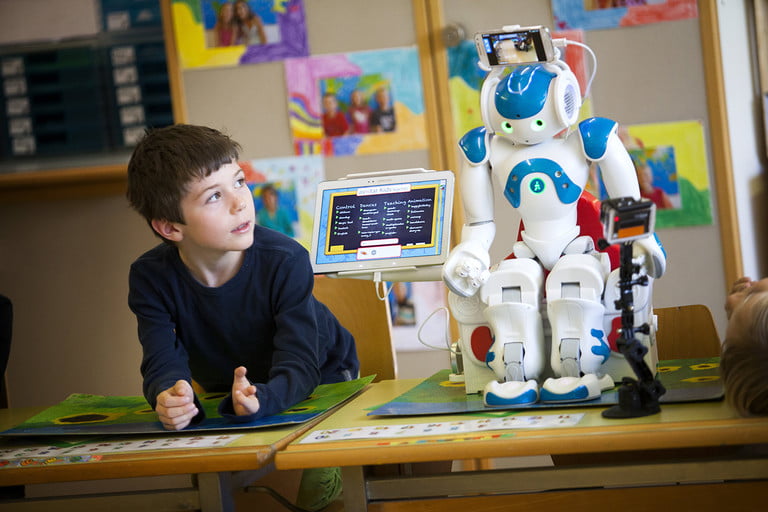 PEDAGOGICAL IMPLICATIONS OF ARTIFICIAL INTELLIGENCE IN CLASSROOMS
PEDAGOGICAL IMPLICATIONS OF ARTIFICIAL INTELLIGENCE IN CLASSROOMSOVER three decades and a half before, when computers made their inroads to schools, they were largely considered as ‘subjects of study’ and they were added as an additional subject to the curriculum. There existed a myth that computers were meant only for students who were good in mathematics and had a technological aptitude. The idea that computers were tools good enough to transact any type of learning and were platforms which could enhance and empower learning, open up possibilities for data analysis, promote analytical thinking and would relieve a number of routine jobs haunted my monotony remained unacceptable for a brief amount of time, due to lack of awareness and the fear of the unknown.
With Artificial intelligence opening up its score in the pitches of the classrooms, such a myth is not likely to be there; yet it is quite possible that the human mind known for its pattern making, may still consider this as another piece of knowledge for transaction. It is quite important to demystify this idea among the schools and teachers right in the beginning. With my minimal understanding of the kind of interventions AI appears to be making in the design of the curriculum and in content development, I do foresee the emerging need for adequate preparation to face the challenges of the classroom. Teachers might have to rewire their brain mechanisms that deal with classroom pedagogy and interactive presentations of the content.

1.Content designs may evolve in new Avatars
Content designs on technological platforms may some new features. With greater possibility of information synthesis, the presentation of contents could become more demonstrative, more functional and more investigative.
“Design thinking” experts may have a significant role to play in identifying learning problems, ideate new methods of communication and put the content to intrinsic tests for promoting curiosity and investigation by the learners. These new interventions will not scale the difficulty levels in understanding, but would indeed provide challenges to the learners to perceive the information from different angles. Reach and operability of the content at the personal level by the learners would largely promote individualized learning. Classrooms might become less homogeneous, but more engaging.
2.Classrooms cannot afford to have “Mass drills”
With greater opportunities for personalized learning encouraging different perceptions to a problem or a concept, teachers cannot afford to have the “mass drill” modes of information processing in classrooms. Teachers might have to address individual curiosities and challenges at the individual level through the platforms of technology. As “Artificial intelligence” interventions would cease to play their initial magic in a short term, the focus will shift to real learning through technology. Teachers might be called upon to review their content more intrinsically to offer the explanations with a greater exactitude and authenticity.
3.Classrooms might have different learning layers
As perceptions to learning would vary from one child to another, (though it exists even now to a limited extent) there will be different learning layers in the classroom. While the speed and levels of understanding could be better with the use of AI, it might lead to a larger number of questions from the learners on “why”, “how” and “what”. With larger visual inputs impacting their learning process, their engagement with learning is likely to be more immersive and hence the urge to challenge will be enhanced. Teachers might have to look at their content to a greater depth and be willing to give better answers, acknowledge their inabilities as and when they encounter conceptual mishaps, thus leading to a researching engagement with their content. This will create several layers of learning in a cohort and might call for a fresh look at their pedagogical deliveries and their evaluation.
4. Extended and connected learning would increase
With new ‘avatars’ of conceptual designs, a lot of supplementary inputs to content design, content architecture and content validation would happen. This will force the learners to seek external avenues for enrichment of their knowledge and skills. Increased desire for experimentation and seeking more information through search engines, connecting knowledge pieces for making newer meanings would challenge the routine classical patterns of classrooms. The Internet of Things, estalblishing huge connectivity between information systems, possibilities of integrated thinking would increase. Indeed, teachers might have to reposition their pedagogical strategies more as a co-learner, enabler, mentor and human resource activist. School libraries would also have to take a new “Avatar” by acting as support centres for teacher empowerment.
5. Need to revisit the types of lesson plans
The classical mode of preparing “lesson plans” might need a holistic review. Though even now, there is a large gap between the prepared lesson plans (Which is done mostly to satisfy an administrative requisite), it would be very difficult to position AI within the framework of the current conceptual delivery of lesson plans. Serious discussions will have to be carried out between pedagogues, and administrators to articulate an ‘acceptable model’ that will reflect effective delivery, productivity and coverage in the classrooms. Possibly more freedom to think, experiment and interact would be the impact of AI in a classroom with a spectrum of learners.
6. School Administrators would have to be more open to experimentation
If AI is fitted into the existing design of pedagogical delivery, it could lead to more chaos and wastage. It is important to position AI as another evolutionary step in learning modelling. That would indeed mean more space, time and freedom to the teachers to absorb and integrate themselves to a newer level. School heads and administrators should provide this freedom to the school community so that the challenges are minimized.
Artificial Intelligence in classrooms has to result in bringing a new life to classrooms facilitating empowerment of human intelligence. “Design Thinkers” might find future quite engaging with these issues.
*This article was originally written on LinkedIn.https://www.linkedin.com/pulse/pedagogical-implications-artificial-intelligence-classrooms-g/
Image courtesy:https://icdn7.digitaltrends.com/image/education-robot-blue-768x768.jpg